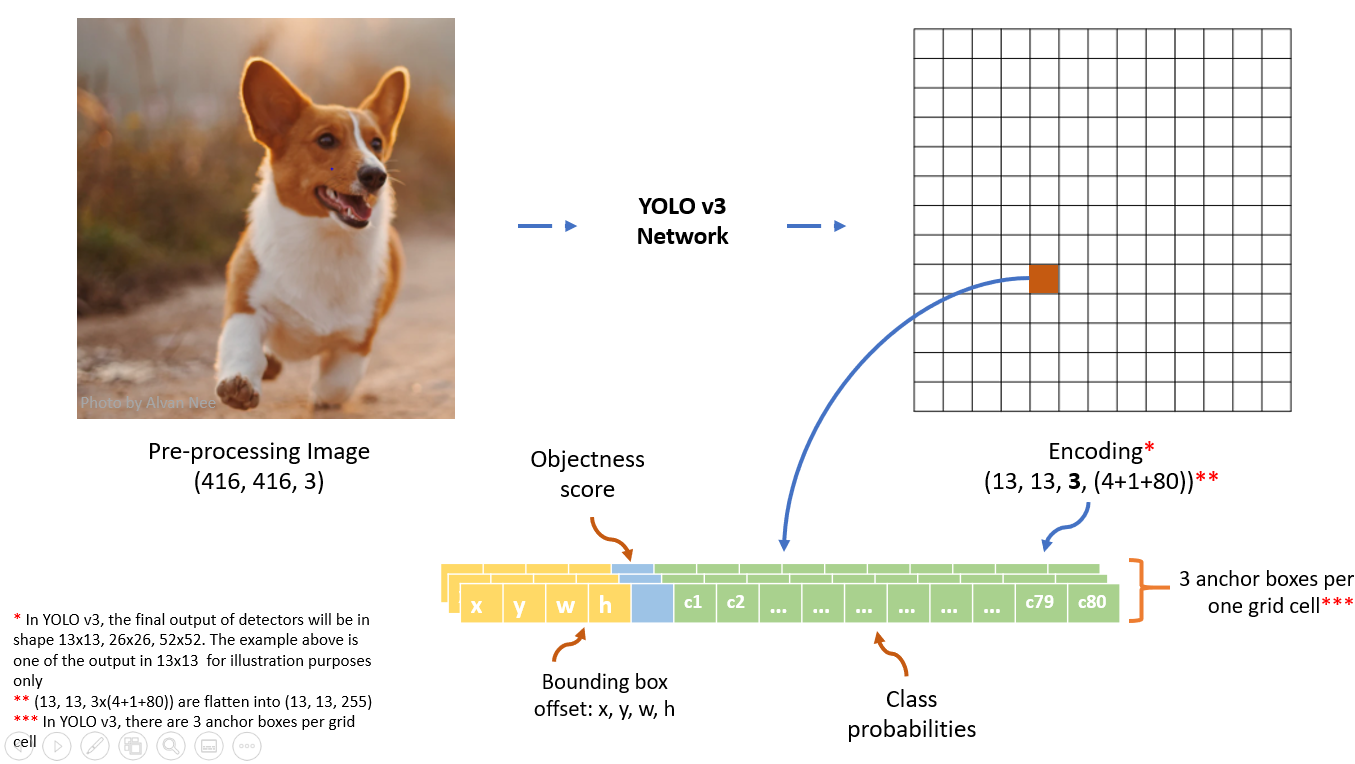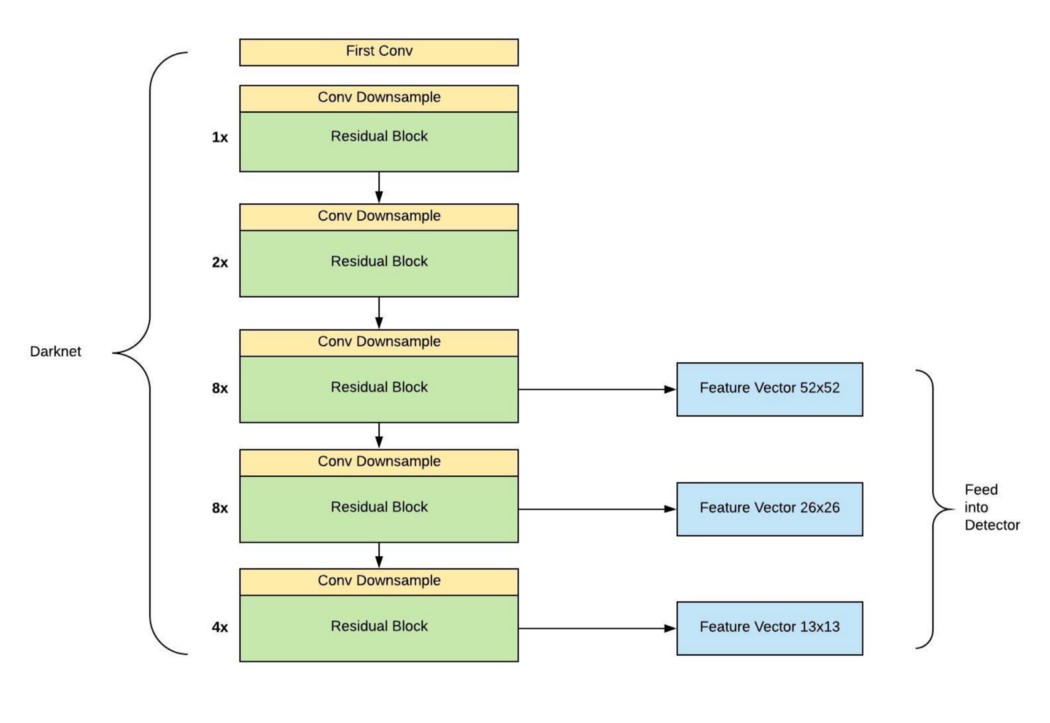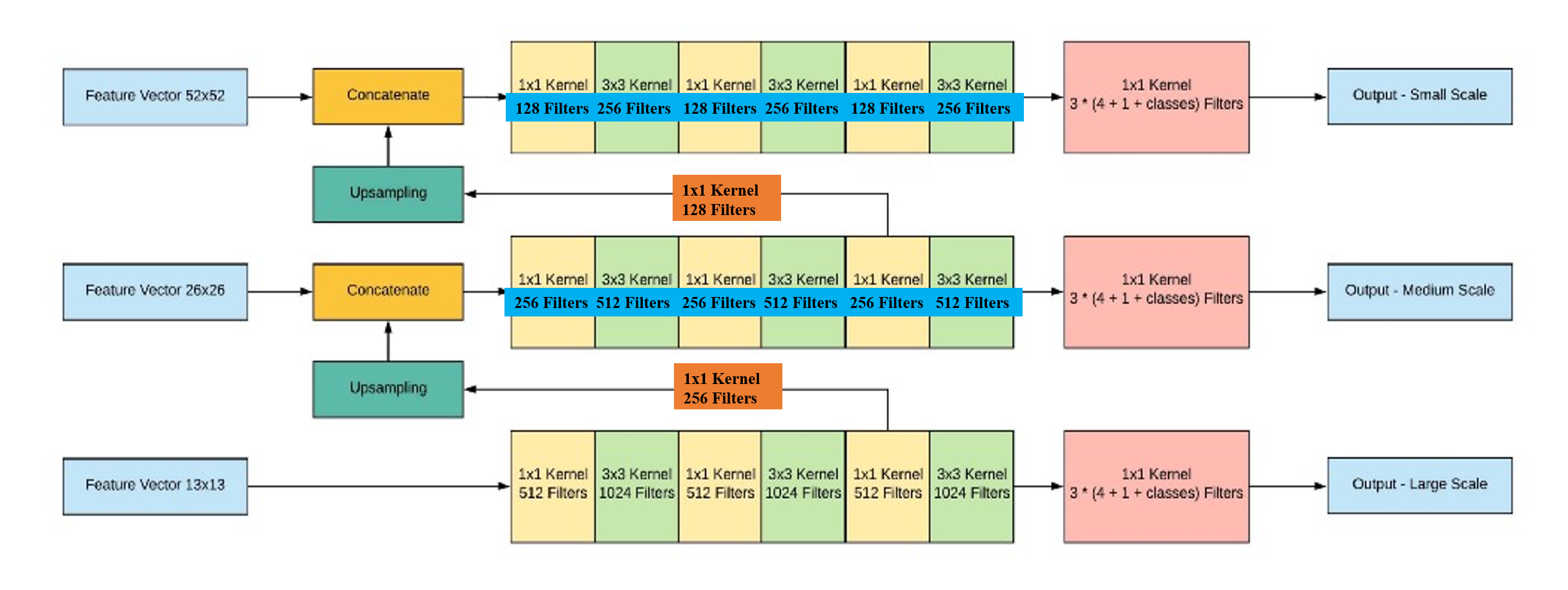YOLO v3算法介绍

图片来自https://towardsdatascience.com/yolo-v3-object-detection-with-keras-461d2cfccef6
数据前处理
输入的图片维数:(416, 416, 3)
输入的图片标注:$[(x_1, y_1, x_2, y_2, class{\_}index), (x_1, y_1, x_2, y_2,class{\_}index), \ldots, (x_1, y_1, x_2, y_2,class{\_}index)]$ 表示图片中标注的所有真实box,其中$class{\_}index$代表对应的box所属的类别,$(x_1, y_1)$表示对应的box左上角的坐标值,$(x_2, y_2)$表示对应的box右下角的坐标值
YOLO v3共有9个anchor box,每个detector中有3个anchor box。YOLO v3中anchor box的确定方法是对训练集中的所有真实box进行聚类得到的,聚类距离通过IoU来定义,IoU越大,距离越小:$$d(\text {box}, \text {centroid})=1-\operatorname{IoU}(\text {box}, \text {centroid})$$IoU的定义如下图所示:

前处理中最重要的一步就是将图片标注转化为模型的输出格式。首先要确定每个box对应哪个anchor box (与box的IoU最大的那个anchor box),然后将box的信息写在对应的anchor box的位置。

###########以下代码仅用作说明,并未考虑性能和代码结构########## train_output_sizes = [52, 26, 13] label = [np.zeros((train_output_sizes[i], train_output_sizes[i], 3, 85)) for i in range(3)] bboxes_count = np.zeros((3,)) max_bbox_per_scale = 150 #每个detector中具有的真实box的最大数量 bboxes_xywh = [np.zeros((max_bbox_per_scale, 4)) for _ in range(3)] # YOLO v3默认的9个anchor box的width和height anchors = [[(10,13), (16,30), (33,23)], [(30,61), (62,45), (59,119)], [(116,90), (156,198), (373,326)]] # bboxes为一张图片中标注的所有真实box for bbox in bboxes: bbox_coor = bbox[:4] bbox_class_ind = bbox[4] #onehot encode for class onehot = np.zeros(80, dtype=np.float) onehot[bbox_class_ind] = 1.0 # 将box的坐标(x1,y1,x2,y2)转换成(xc, yc, width, height) bbox_xywh = np.concatenate([(bbox_coor[2:] + bbox_coor[:2]) * 0.5, bbox_coor[2:] - bbox_coor[:2]], axis=-1) # 找到和box有最大IoU的anchor box iou = [] for anchors_detector in anchors: for anchor in anchors_detector: intersection = min(bbox_xywh[2], anchor[0])*min(bbox_xywh[3], anchor[1]) box_area = bbox_xywh[2]*bbox_xywh[3] anchor_area = anchor[0] * anchor[1] iou.append(intersection / (box_area + anchor_area - intersection)) anchor_idx = np.argmax(np.array(iou)) # 将anchor_idx转换到对应的输出位置 best_detect = int(anchor_idx/3) best_anchor = int(anchor_idx % 3) scale = int(416/train_output_sizes[best_detect]) xind, yind = int(bbox_xywh[0]/scale), int(bbox_xywh[1]/scale) label[best_detect][yind, xind, best_anchor, 0:4] = bbox_xywh label[best_detect][yind, xind, best_anchor, 4:5] = 1.0 label[best_detect][yind, xind, best_anchor, 5:] = onehot # 存储box的信息 bboxes_xywh[best_detect][bboxes_count[best_detect], :4] = bbox_xywh bboxes_count[best_detect] += 1 label_sbbox, label_mbbox, label_lbbox = label sbboxes, mbboxes, lbboxes = bboxes_xywh
模型架构
YOLO v3的架构搭建主要分为两个部分,第一部分基于Darknet网络构建52x52, 26x26, 13x13的特征图,第二部分构建基于这三类特征图的探测器,如下图所示:


图片来自https://towardsdatascience.com/dive-really-deep-into-yolo-v3-a-beginners-guide-9e3d2666280e (对其中的错误进行了修正)

### convolutional and residual blocks def _conv_block(inp, convs, skip=True): x = inp count = 0 for conv in convs: # skip over 2 layers if count == (len(convs) - 2) and skip: skip_connection = x count += 1 if conv['stride'] > 1: x = ZeroPadding2D(((1,0),(1,0)))(x) # left and top padding x = Conv2D(conv['filter'], conv['kernel'], strides=conv['stride'], padding='valid' if conv['stride'] > 1 else 'same', name='conv_' + str(conv['layer_idx']), use_bias=False if conv['bnorm'] else True)(x) if conv['bnorm']: x = BatchNormalization(epsilon=0.001, name='bnorm_' + str(conv['layer_idx']))(x) if conv['leaky']: x = LeakyReLU(alpha=0.1, name='leaky_' + str(conv['layer_idx']))(x) return Add()([skip_connection, x]) if skip else x ### backbone def make_yolov3_model(): input_image = Input(shape=(None, None, 3)) #(416, 416,3) ###### Part 1 ###### # (208, 208, 64) x = _conv_block(input_image, [{'filter': 32, 'kernel': 3, 'stride': 1, 'bnorm': True, 'leaky': True, 'layer_idx': 0}, {'filter': 64, 'kernel': 3, 'stride': 2, 'bnorm': True, 'leaky': True, 'layer_idx': 1}, {'filter': 32, 'kernel': 1, 'stride': 1, 'bnorm': True, 'leaky': True, 'layer_idx': 2}, {'filter': 64, 'kernel': 3, 'stride': 1, 'bnorm': True, 'leaky': True, 'layer_idx': 3}]) # (104, 104, 128) x = _conv_block(x, [{'filter': 128, 'kernel': 3, 'stride': 2, 'bnorm': True, 'leaky': True, 'layer_idx': 5}, {'filter': 64, 'kernel': 1, 'stride': 1, 'bnorm': True, 'leaky': True, 'layer_idx': 6}, {'filter': 128, 'kernel': 3, 'stride': 1, 'bnorm': True, 'leaky': True, 'layer_idx': 7}]) # (104, 104, 128) x = _conv_block(x, [{'filter': 64, 'kernel': 1, 'stride': 1, 'bnorm': True, 'leaky': True, 'layer_idx': 9}, {'filter': 128, 'kernel': 3, 'stride': 1, 'bnorm': True, 'leaky': True, 'layer_idx': 10}]) # (52, 52, 256) x = _conv_block(x, [{'filter': 256, 'kernel': 3, 'stride': 2, 'bnorm': True, 'leaky': True, 'layer_idx': 12}, {'filter': 128, 'kernel': 1, 'stride': 1, 'bnorm': True, 'leaky': True, 'layer_idx': 13}, {'filter': 256, 'kernel': 3, 'stride': 1, 'bnorm': True, 'leaky': True, 'layer_idx': 14}]) # (52, 52, 256) for i in range(7): x = _conv_block(x, [{'filter': 128, 'kernel': 1, 'stride': 1, 'bnorm': True, 'leaky': True, 'layer_idx': 16+i*3}, {'filter': 256, 'kernel': 3, 'stride': 1, 'bnorm': True, 'leaky': True, 'layer_idx': 17+i*3}]) skip_36 = x #52x52 feature map # (26, 26, 512) x = _conv_block(x, [{'filter': 512, 'kernel': 3, 'stride': 2, 'bnorm': True, 'leaky': True, 'layer_idx': 37}, {'filter': 256, 'kernel': 1, 'stride': 1, 'bnorm': True, 'leaky': True, 'layer_idx': 38}, {'filter': 512, 'kernel': 3, 'stride': 1, 'bnorm': True, 'leaky': True, 'layer_idx': 39}]) # (26, 26, 512) for i in range(7): x = _conv_block(x, [{'filter': 256, 'kernel': 1, 'stride': 1, 'bnorm': True, 'leaky': True, 'layer_idx': 41+i*3}, {'filter': 512, 'kernel': 3, 'stride': 1, 'bnorm': True, 'leaky': True, 'layer_idx': 42+i*3}]) skip_61 = x #26x26 feature map # (13, 13, 1024) x = _conv_block(x, [{'filter': 1024, 'kernel': 3, 'stride': 2, 'bnorm': True, 'leaky': True, 'layer_idx': 62}, {'filter': 512, 'kernel': 1, 'stride': 1, 'bnorm': True, 'leaky': True, 'layer_idx': 63}, {'filter': 1024, 'kernel': 3, 'stride': 1, 'bnorm': True, 'leaky': True, 'layer_idx': 64}]) # (13, 13, 1024) for i in range(3): x = _conv_block(x, [{'filter': 512, 'kernel': 1, 'stride': 1, 'bnorm': True, 'leaky': True, 'layer_idx': 66+i*3}, {'filter': 1024, 'kernel': 3, 'stride': 1, 'bnorm': True, 'leaky': True, 'layer_idx': 67+i*3}]) #13x13 feature map ###### Part 2 ###### # (13, 13, 512) x = _conv_block(x, [{'filter': 512, 'kernel': 1, 'stride': 1, 'bnorm': True, 'leaky': True, 'layer_idx': 75}, {'filter': 1024, 'kernel': 3, 'stride': 1, 'bnorm': True, 'leaky': True, 'layer_idx': 76}, {'filter': 512, 'kernel': 1, 'stride': 1, 'bnorm': True, 'leaky': True, 'layer_idx': 77}, {'filter': 1024, 'kernel': 3, 'stride': 1, 'bnorm': True, 'leaky': True, 'layer_idx': 78}, {'filter': 512, 'kernel': 1, 'stride': 1, 'bnorm': True, 'leaky': True, 'layer_idx': 79}], skip=False) # (13, 13, 255) yolo_82 = _conv_block(x, [{'filter': 1024, 'kernel': 3, 'stride': 1, 'bnorm': True, 'leaky': True, 'layer_idx': 80}, {'filter': 255, 'kernel': 1, 'stride': 1, 'bnorm': False, 'leaky': False, 'layer_idx': 81}], skip=False) #13x13 detector # concatenate with 26x26 feature map, (26, 26, 256+512) x = _conv_block(x, [{'filter': 256, 'kernel': 1, 'stride': 1, 'bnorm': True, 'leaky': True, 'layer_idx': 84}], skip=False) x = UpSampling2D(2)(x) x = Concatenate()([x, skip_61]) # (26, 26, 256) x = _conv_block(x, [{'filter': 256, 'kernel': 1, 'stride': 1, 'bnorm': True, 'leaky': True, 'layer_idx': 87}, {'filter': 512, 'kernel': 3, 'stride': 1, 'bnorm': True, 'leaky': True, 'layer_idx': 88}, {'filter': 256, 'kernel': 1, 'stride': 1, 'bnorm': True, 'leaky': True, 'layer_idx': 89}, {'filter': 512, 'kernel': 3, 'stride': 1, 'bnorm': True, 'leaky': True, 'layer_idx': 90}, {'filter': 256, 'kernel': 1, 'stride': 1, 'bnorm': True, 'leaky': True, 'layer_idx': 91}], skip=False) # (26, 26, 255) yolo_94 = _conv_block(x, [{'filter': 512, 'kernel': 3, 'stride': 1, 'bnorm': True, 'leaky': True, 'layer_idx': 92}, {'filter': 255, 'kernel': 1, 'stride': 1, 'bnorm': False, 'leaky': False, 'layer_idx': 93}], skip=False) #26x26 detector # concatenate with 52x52 feature map, (52, 52, 128+256) x = _conv_block(x, [{'filter': 128, 'kernel': 1, 'stride': 1, 'bnorm': True, 'leaky': True, 'layer_idx': 96}], skip=False) x = UpSampling2D(2)(x) x = Concatenate()([x, skip_36]) # (52, 52, 255) yolo_106 = _conv_block(x, [{'filter': 128, 'kernel': 1, 'stride': 1, 'bnorm': True, 'leaky': True, 'layer_idx': 99}, {'filter': 256, 'kernel': 3, 'stride': 1, 'bnorm': True, 'leaky': True, 'layer_idx': 100}, {'filter': 128, 'kernel': 1, 'stride': 1, 'bnorm': True, 'leaky': True, 'layer_idx': 101}, {'filter': 256, 'kernel': 3, 'stride': 1, 'bnorm': True, 'leaky': True, 'layer_idx': 102}, {'filter': 128, 'kernel': 1, 'stride': 1, 'bnorm': True, 'leaky': True, 'layer_idx': 103}, {'filter': 256, 'kernel': 3, 'stride': 1, 'bnorm': True, 'leaky': True, 'layer_idx': 104}, {'filter': 255, 'kernel': 1, 'stride': 1, 'bnorm': False, 'leaky': False, 'layer_idx': 105}], skip=False) #52x52 detector model = Model(input_image, [yolo_82, yolo_94, yolo_106]) return model
损失函数
YOLO v3中的损失函数有许多不同的变种,这里选取一种比较经典的进行介绍。损失函数可以分解为边框损失、目标损失以及分类损失这三项之和,下面对这三项逐一进行介绍。
边框损失:原始论文中使用MSE(均方误差)作为边框的损失函数,但是不同质量的预测结果,利用MSE有时候并不能区分开来。使用IoU更能体现回归框的质量,并且具有尺度不变性,但是IoU仅能描述两个边框重叠的面积,不能描述两个边框重叠的形式;并且若两个边框完全不相交,则IoU为0,不适合继续进行梯度优化。GIoU (Generalized IoU)继承了IoU的优点,并且一定程度上解决了IoU存在的问题:$$G I o U=I o U-\frac{|C \backslash(B_1 \cup B_2)|}{|C|}$$其中$C$为包含$B_1$与$B_2$的最小封闭形状。边框损失可表示为$1-G I o U$,下面以13x13这一检测器为例来计算边框损失,总的边框损失为三个检测器的损失之和。
要计算边框损失,首先要对YOLO v3的网络输出进行转换,假设网络输出的边框信息为$(t_x,t_y,t_w,t_h)$,其中$(t_x,t_y)$为边框中心点信息,$(t_w,t_h)$为边框的宽度和高度信息,转换公式如下所示:$$b_x=sigmoid(t_x)+c_x;\text{ }b_y=sigmoid(t_y)+c_y;\text{ }b_w=p_wexp(t_w);\text{ }b_h=p_hexp(t_h)$$其中$(c_x,c_y)$表示$(t_x,t_y)$所在网格的左上角那个点的坐标位置,$(p_w,p_h)$表示边框对应的anchor box的宽度和高度。

output_size = 13 anchors = np.array([[116,90], [156,198], [373,326]]) #anchor boxes in 13x13 detector, 参见数据前处理代码部分 # yolo_82_batch: 13x13 detector output, (batch_size, 13, 13, 255), yolo_82的计算参见模型架构代码部分 conv_output = tf.reshape(yolo_82_batch, (batch_size, output_size, output_size, 3, 85)) #(batch_size, 13, 13, 3, 85) t_xy, t_wh, objectness, classes = tf.split(conv_output, (2, 2, 1, 80), axis=-1) #t_xy:(batch_size, 13, 13, 3, 2); t_wh:(batch_size, 13, 13, 3, 2) c_xy = tf.meshgrid(tf.range(output_size), tf.range(output_size)) #a list of two (13,13) arrays c_xy = tf.stack(c_xy, axis=-1) #(13,13,2) c_xy = tf.tile(c_xy[tf.newaxis, :, :, tf.newaxis, :], [batch_size, 1, 1, 3, 1]) #(batch_size,13,13,3,2) scale = int(416/output_size) b_xy = (tf.sigmoid(t_xy) + c_xy) * scale #(batch_size,13,13,3,2) b_wh = tf.exp(t_wh) * anchors #(batch_size,13,13,3,2) b_xywh = tf.concat([b_xy, b_wh], axis=-1) #(batch_size,13,13,3,4)
接下来计算网络输出的边框与真实边框的GIoU,进而得到边框损失:

def bbox_giou(boxes1, boxes2): # transform from (xc, yc, w, h) to (xmin, ymin, xmax, ymax) boxes1 = tf.concat([boxes1[..., :2] - boxes1[..., 2:] * 0.5, boxes1[..., :2] + boxes1[..., 2:] * 0.5], axis=-1) boxes2 = tf.concat([boxes2[..., :2] - boxes2[..., 2:] * 0.5, boxes2[..., :2] + boxes2[..., 2:] * 0.5], axis=-1) # two box aeras boxes1_area = (boxes1[..., 2] - boxes1[..., 0]) * (boxes1[..., 3] - boxes1[..., 1]) boxes2_area = (boxes2[..., 2] - boxes2[..., 0]) * (boxes2[..., 3] - boxes2[..., 1]) # intersection area left_up = tf.maximum(boxes1[..., :2], boxes2[..., :2]) right_down = tf.minimum(boxes1[..., 2:], boxes2[..., 2:]) inter_section = tf.maximum(right_down - left_up, 0.0) inter_area = inter_section[..., 0] * inter_section[..., 1] # compute iou union_area = boxes1_area + boxes2_area - inter_area iou = inter_area / union_area # enclosed area enclose_left_up = tf.minimum(boxes1[..., :2], boxes2[..., :2]) enclose_right_down = tf.maximum(boxes1[..., 2:], boxes2[..., 2:]) enclose = tf.maximum(enclose_right_down - enclose_left_up, 0.0) enclose_area = enclose[..., 0] * enclose[..., 1] # compute giou giou = iou - 1.0 * (enclose_area - union_area) / enclose_area return giou ### label_lbbox_batch: ground truth boxes in 13x13 detector, (batch_size, 13, 13, 3, 85), label_lbbox的计算参见数据前处理代码部分 label_xywh = label_lbbox_batch[:, :, :, :, 0:4] #ground truth box (xc, yc, w, h) respond_bbox = label_lbbox_batch[:, :, :, :, 4:5] #对应的anchor box内是否有真实对象存在,为1则计算边框损失,为0则忽略 giou = tf.expand_dims(bbox_giou(b_xywh, label_xywh), axis=-1) #(batch_size, 13, 13, 3, 1) input_size = tf.cast(416, tf.float32) bbox_loss_scale = 2.0 - 1.0 * label_xywh[:, :, :, :, 2:3] * label_xywh[:, :, :, :, 3:4] / (input_size ** 2) #边框损失的权重,对应的ground truth box的面积越大,对错误的容忍率越高,赋予的权重越小 giou_loss = respond_bbox * bbox_loss_scale * (1- giou) #giou loss, (batch_size, 13, 13, 3, 1)
目标损失:仍以13x13这一检测器为例来计算,目标损失实际上是一个不平衡二分类问题,因为一般来说检测器的13x13x3个anchor box内真实对象(正样本)的数量要远小于没有真实对象(负样本)的数量。采用Focal Loss来处理这一问题,Focal Loss对难分类的样本采用较大的权重,对易分类的样本采用较小的权重:$$F L(p)=\left\{\begin{aligned}-(1-p)^{\gamma} \log (p), & \text { positive samples } \\ -p^{\gamma} \log (1-p), & \text { negative samples }\end{aligned}\right.$$Focal Loss还有另外一种公式,即在上述基础上引入类别权重$\alpha$:$$F L(p)=\left\{\begin{aligned}-\alpha(1-p)^{\gamma} \log (p), & \text { positive samples} \\ -(1-\alpha) p^{\gamma} \log (1-p), & \text { negative samples }\end{aligned}\right.$$本文采用第一种公式,并将$\gamma$设为2。另外在目标损失的计算过程中对负样本的定义进行了一定修改,如果一个anchor box内没有真实对象,但它预测的边框和对应的探测器上的某个真实边框有较大的IoU,那么就不把它作为负样本,从而在损失计算过程中忽略它,这也在一定程度上减少了负样本的数量。

### lbboxes_batch: 13x13探测器上存在的所有ground truth box的(xc,yc,w,h)信息, (batch_size, max_bbox_per_scale, 4), lbboxes的计算参见数据前处理代码部分 ### label_lbbox_batch: ground truth boxes in 13x13 detector, (batch_size, 13, 13, 3, 85), label_lbbox的计算参见数据前处理代码部分 ### objectness:预测的对象真实度, (batch_size, 13, 13, 3, 1), 参见边框损失中的输出转换代码部分 ### b_xywh: 预测的边框信息,(batch_size, 13, 13, 3, 4), 参见边框损失中的输出转换代码部分 respond_bbox = label_lbbox_batch[:, :, :, :, 4:5] #对应的anchor box内是否有真实对象存在,为1则为正样本,为0则为负样本 ### 减少进行计算的负样本的数量 ### ### 1. 计算预测的box与所有真实box的IoU ### boxes1 = tf.tile(lbboxes_batch[:, tf.newaxis, tf.newaxis, tf.newaxis, :, :], [1, 13, 13, 3, 1, 1]) #(batch_size, 13, 13, 3, max_bbox_per_scale, 4) boxes2 = tf.tile(b_xywh[:, :, :, :, tf.newaxis, :], [1, 1, 1, 1, max_bbox_per_scale, 1]) #(batch_size, 13, 13, 3, max_bbox_per_scale, 4) boxes1_area = boxes1[..., 2] * boxes1[..., 3] boxes2_area = boxes2[..., 2] * boxes2[..., 3] # (xc, yc, w, h)->(xmin, ymin, xmax, ymax) boxes1 = tf.concat([boxes1[..., :2] - boxes1[..., 2:] * 0.5, boxes1[..., :2] + boxes1[..., 2:] * 0.5], axis=-1) boxes2 = tf.concat([boxes2[..., :2] - boxes2[..., 2:] * 0.5, boxes2[..., :2] + boxes2[..., 2:] * 0.5], axis=-1) # compute IoU left_up = tf.maximum(boxes1[..., :2], boxes2[..., :2]) right_down = tf.minimum(boxes1[..., 2:], boxes2[..., 2:]) inter_section = tf.maximum(right_down - left_up, 0.0) inter_area = inter_section[..., 0] * inter_section[..., 1] union_area = boxes1_area + boxes2_area - inter_area iou = 1.0 * inter_area / union_area #(batch_size, 13, 13, 3, max_bbox_per_scale) ### 2. 寻找最大的IoU,若该值大于给定的临界值,则在损失计算中忽略该样本### max_iou = tf.expand_dims(tf.reduce_max(iou, axis=-1), axis=-1) #(batch_size, 13, 13, 3, 1) IOU_LOSS_THRESH = 0.5 respond_bgd = (1.0 - respond_bbox) * tf.cast( max_iou < IOU_LOSS_THRESH, tf.float32) #(batch_size, 13, 13, 3, 1) ########################### pred_conf = tf.sigmoid(objectness) #预测为真实对象的概率 conf_focal = tf.pow(respond_bbox - pred_conf, 2) #gamma=2 focal_loss_p = conf_focal * respond_bbox * tf.nn.sigmoid_cross_entropy_with_logits(labels=respond_bbox, logits=objectness) #正样本损失 focal_loss_n = conf_focal * respond_bgd * tf.nn.sigmoid_cross_entropy_with_logits(labels=respond_bbox, logits=objectness) #负样本损失 focal_loss = focal_loss_p + focal_loss_n #(batch_size, 13, 13, 3, 1)
分类损失:仍以13x13这一检测器为例来计算,使用交叉熵损失函数,值得注意的是在YOLO v3的类别预测中使用sigmoid作为激活函数代替之前的softmax,主要是因为不同的类别不一定是互斥的,一个对象可能会同时属于多个类别。

### label_lbbox_batch: ground truth boxes in 13x13 detector, (batch_size, 13, 13, 3, 85), label_lbbox的计算参见数据前处理代码部分 ### classes: 预测对象所属的类别,(batch_size, 13, 13, 3, 80), 参见边框损失中的输出转换代码部分 respond_bbox = label_lbbox_batch[:, :, :, :, 4:5] #对应的anchor box内是否有真实对象存在,为1则计算分类损失,为0则忽略 labels_onehot = label_lbbox_batch[:, :, :, :, 5:] #对象所属的真实类别 classes_prob = tf.sigmoid(classes) #预测属于每个类别的概率 ce_loss = respond_bbox * tf.nn.sigmoid_cross_entropy_with_logits(labels=labels_onehot, logits=classes) #cross entropy loss, (batch_size, 13, 13, 3, 80)
综合上述的三类损失,可以计算出在13x13探测器上的总损失,其余两个探测器 (26x26, 52x52) 上的损失可采取同样的方法计算,三个探测器的总损失为:

giou_loss_13 = tf.reduce_mean(tf.reduce_sum(giou_loss, axis=[1,2,3,4])) focal_loss_13 = tf.reduce_mean(tf.reduce_sum(focal_loss, axis=[1,2,3,4])) ce_loss_13 = tf.reduce_mean(tf.reduce_sum(ce_loss, axis=[1,2,3,4])) total_loss_13 = giou_loss_13 + focal_loss_13 + ce_loss_13 # total loss total_loss = total_loss_13 + total_loss_26 + total_loss_52
模型预测
同损失函数这一部分中的介绍,首先将网络输出的格式进行转换:

### 仍以13x13检测器为例, 输入的待预测图片的维数为(1, 416, 416, 3) ### b_xywh, pred_conf, classes_prob的计算参见损失函数代码部分 output_13 = tf.concat([b_xywh, pred_conf, classes_prob], axis=-1) #(batch_size, 13, 13, 3, 85),此时的batch_size为1 ### 同样的方式可以计算出output_26 (26x26检测器), output_52 (52x52检测器) ### output_26: (1, 26, 26, 3, 85); output_52: (1, 52, 52, 3, 85) pred_bbox = [tf.reshape(x, (-1, tf.shape(x)[-1])) for x in (output_13, output_26, output_52)] #[(13*13*3, 85), (26*26*3, 85), (52*52*3, 85)] pred_bbox = tf.concat(pred_bbox, axis=0) #预测得到的所有box的信息, (13*13*3+26*26*3+52*52*3, 85)
接下来删除得分较低的预测box,得分通过box内为真实对象的概率乘以最大的类别概率进行确定

score_threshold = 0.5 pred_xywh = pred_bbox[:, 0:4] # (xc, yc, w, h) --> (xmin, ymin, xmax, ymax) for computing IoU pred_coor = np.concatenate([pred_xywh[:, :2] - pred_xywh[:, 2:] * 0.5, pred_xywh[:, :2] + pred_xywh[:, 2:] * 0.5], axis=-1) # compute box score pred_conf = pred_bbox[:, 4] pred_prob = pred_bbox[:, 5:] classes = np.argmax(pred_prob, axis=-1) #每个box预测的对应最大概率的类别 scores = pred_conf * np.max(pred_prob, axis=-1) # discard boxes with low scores mask = scores > score_threshold coors, scores, classes = pred_coor[mask], scores[mask], classes[mask] filter_boxes = np.concatenate([coors, scores[:, np.newaxis], classes[:, np.newaxis]], axis=-1) #(number of remaining boxes, 6)
对剩余的预测box进行Non-Maximum Suppression (NMS),NMS的主要目的是去除预测类别相同但是重叠度比较大的box:


iou_threshold = 0.5 classes_in_img = list(set(filter_boxes[:, 5])) #图片上的所有预测类别 best_bboxes = [] #最终剩余的box for cls in classes_in_img: cls_mask = (filter_boxes[:, 5] == cls) cls_bboxes = filter_boxes[cls_mask] #预测为同一类别的所有box while len(cls_bboxes) > 0: max_ind = np.argmax(cls_bboxes[:, 4]) best_bbox = cls_bboxes[max_ind] #剩余box中得分最高的box best_bboxes.append(best_bbox) ### 计算得分最高的box与剩余box的IoU ### cls_bboxes = np.concatenate([cls_bboxes[: max_ind], cls_bboxes[max_ind + 1:]], axis=0) #剩余box (不包括得分最高的box) best_bbox_xy = best_bbox[np.newaxis, :4] cls_bboxes_xy = cls_bboxes[:, :4] ### IoU best_bbox_area = (best_bbox_xy[:, 2] - best_bbox_xy[:, 0]) * (best_bbox_xy[:, 3] - best_bbox_xy[:, 1]) cls_bboxes_area = (cls_bboxes_xy[:, 2] - cls_bboxes_xy[:, 0]) * (cls_bboxes_xy[:, 3] - cls_bboxes_xy[:, 1]) left_up = np.maximum(best_bbox_xy[:, :2], cls_bboxes_xy[:, :2]) right_down = np.minimum(best_bbox_xy[:, 2:], cls_bboxes_xy[:, 2:]) inter_section = np.maximum(right_down - left_up, 0.0) inter_area = inter_section[:, 0] * inter_section[:, 1] union_area = cls_bboxes_area + best_bbox_area - inter_area ious = 1.0 * inter_area / union_area ### 删除与得分最高的box的IoU较大的box ### iou_mask = ious < iou_threshold cls_bboxes = cls_bboxes[iou_mask]
参考资料
- 本文主要针对YOLO v3的细节进行了总结,对目标检测以及YOLO系列的基础概念并未详细说明,这部分可以参考Coursera上深度学习专项课程中的Convolutional Neural Networks
- 本文的代码部分仅是为了用于说明,并没有进行系统地设计和优化,YOLO v3的代码可以参考以下链接
- 其它资料
- https://towardsdatascience.com/yolo-v3-object-detection-with-keras-461d2cfccef6
- https://towardsdatascience.com/dive-really-deep-into-yolo-v3-a-beginners-guide-9e3d2666280e
- https://machinelearningmastery.com/how-to-perform-object-detection-with-yolov3-in-keras/
- CVPR2019: 使用GIoU作为检测任务的Loss
- Focal Loss for Dense Object Detection




